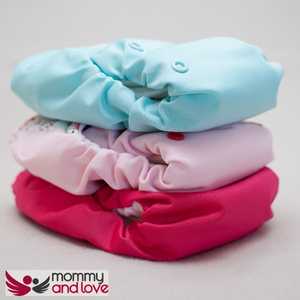Ok, we’ve all heard of the benefits of apple cider vinegar to treat diaper rash (if you haven’t check out our complete guide here). However, white vinegar? We dig deep into this and see if it’s worth trying too.
If you are reading this, I assume you already know what diaper rash is so I’ll just dive straight into the purpose of this article. What will be discussed here are the properties of white vinegar and its effectiveness in treating diaper rash. Sneak reveal, yes it works!
Does White Vinegar Work on Diaper Rashes?
Yes! White vinegar is an effective natural remedy to get rid of diaper rashes. A coating of white vinegar on the skin will help stop the yeast from growing and spreading further. The anti-fungal properties in white vinegar will also disinfect and heal the affected area quickly. It is recommended to use this remedy once or twice a day for fast results.
What is White Vinegar?
White vinegar is simply distilled acetic acid. It’s more diluted than apple cider vinegar and the end-product has a lower pH (2.4-3).
Works best on:
Diaper rash, yeast infection, fungal infections
How to use:
Disinfectants work by denaturing protein and dissolving microbes’ cell membranes. This makes it easier for white vinegar to break down the microbe’s inner workings (DNA and such) since its membrane is already compromised.
It can be used with or without water, although most people prefer using it without water because of its acidic pH.
What are the Benefits of White Vinegar for Diaper Rashes?
There are loads of benefits to using white vinegar over apple cider vinegar or even other diaper rash ointments.
1. Natural way to treat yeast infection

The acidic nature of white vinegar allows it to detach the fungus from the skin.
This will help stop the spread of yeast, so you can prevent further damage and increase moisture levels on the affected area for faster healing.
If you have a yeast diaper rash treat with vinegar has been proven to kill the candida spores in the baby’s diaper rash.
A yeast rash or yeast overgrowth is soothed and cleared using vinegar and unlike many treatments, it’s safe on a baby’s delicate skin. Finish the diaper change with a natural baby powder like corn starch to keep the skin dry and the baby’s rash should clear up much more quickly. Note you can use corn starch powder on yeast rashes!
2. Prevents Infection
A coating of white vinegar on the skin will kill off any microorganisms present. This will keep the area disinfected and prevent infection from growing further. Use it as a spray or mix with a few drops with coconut oil, olive oil or shea butter as one of the great natural remedies to prevent diaper rash. Its much nicer than using petroleum jelly on sensitive skin.
3. Prevents wetness
The acidic compound of white vinegar acts as an astringent. The skin pores will be contracted, which blocks entry to air or water thus creating a more effective barrier against wetness and fungi which causes diaper rashes.
4. Prevents diaper rash in babies
This is done by disinfecting the skin and increasing moisture levels on the skin to help prevent yeast infections. Its’ also cloth diaper safe like raw apple cider vinegar. Always remember to change diapers frequently (whether cloth or disposable diapers) and keep the baby’s skin dry. Never leave a soiled diaper on baby!
Why use White Vinegar for Diaper Rashes?
1. Saves you money (and the environment)
Apple cider vinegar is much more expensive than white vinegar, which means it will save you lots of money in the long run if you are already using white vinegar for other purposes in your household. It’s also more environmentally friendly!
2. No need to dilute
Since white vinegar is diluted, it doesn’t require dilution before application. This saves you a lot of running and time since you don’t have to run or boil water just to dilute the vinegar. You can also use it in baby’s bathwater as its safe and soothing on baby’s skin. A free drop in half a bucket of water for cloth diapering will work.
3. More practical for everyday use
White vinegar is much more common and it’s readily available in most grocery stores. It can be used as a household cleaner, deodorizer, etc., because of its dilute nature. Apple cider vinegar, on the other hand, is not commonly sold in grocery stores and requires extra effort to produce it yourself or procure it from online shops.
4. More convenient storage
White vinegar can be stored anywhere. It can even be safely kept in plastic bottles. White vinegar is also much safer to handle since it contains less acid.
Diaper rash spray for baby
2 tbsp white vinegar (15ml)
1/4 cup water (62.5ml)
2 drops lavender oil (read our guide on essential oils to treat diaper rash)
Mix all the ingredients together and pour into a glass spray bottle. Shake before each use and spray on the affected area. Reapply as needed depending on how bad the diaper rash is. You can use this with cotton wipes instead of using disposable wipes when putting on a new diaper. Add it with coconut oil to create a protective barrier, just a thin layer will help!
Yeast infection relief wash
1 tbsp white vinegar (15ml)
3 tbsp water (45ml)
Mix all the ingredients together and pour into a glass bottle. Shake before each use to mix contents, then apply externally to the yeast infection area. Reapply as needed depending on how bad the yeast infection is.
Note: If you are concerned about the acidity of white vinegar for use on the diaper area, you can dilute it with water.
White vinegar is one of the most commonly used home remedies for diaper rash. It has an antiseptic property that prevents the yeast from spreading further. All you have to do is soak a cotton ball in white vinegar and apply it on your baby’s bottom before putting on their diaper.
Let it dry and then put on a clean diaper at diaper change time. You can also use a spray bottle to spritz some vinegar onto the baby’s bottom before putting a fresh diaper over it and let it dry naturally.
This is one of the best home remedies for diaper rash as this cheap solution will give relief quickly without posing any side effects or risks to your baby. This remedy is especially recommended
In a bottle with a dropper add the following:
1 cup white vinegar, 1/4 tsp baking soda, 30 drops of lavender essential oil. Fill the rest of the bottle up with distilled water. Shake well to mix and use this solution on your baby instead of diaper cream.
The vinegar will help the yeast stop spreading and the baking soda softens the skin, lavender essential oil will help heal the skin. Keep out of eyes.
The vinegar will kill all candida/yeast that is growing on your baby’s bum diaper area. This helps PREVENT future diaper rashes from occurring.
Vinegar is an all-around wonder that everyone should have a bottle of in their home. We hope this article was able to answer your question, “Can White Vinegar Treat Diaper Rash?”. If you have any
Is White Vinegar Safe to Use With Cloth Diapers?

Yes! If you are using cloth for baby’s diaper, then it is safe to use white vinegar.
Not all diaper rash creams can be used with cloth diapers, read out guide to safe diaper rash cream to use with cloth diapers here.
You can also use vinegar solution to wash cloth diapers, it will also have the added benefit of cleaning your washing machine!
This is part of our series of natural remedies to treat diaper rash which includes a sitz bath in warm water for diaper rash, zinc oxide, chamomile tea, baths with two tablespoons of baking soda, and just diaper free time and breast milk lotion to help with diaper rash.
Like everything, always look for an allergic reaction when using new treatments and do a skin patch test first!

This article was written by: Gian MIller – Full-Time Writer, Baby Whisperer & Dad of 3.
Gian spends a lot of his time writing. A self-proclaimed baby whisperer, Gian has been through it all with his own children and is passionate about sharing his hard-won wisdom with other parents. When he’s not writing or changing diapers, you can find him playing the guitar or watching baseball (or preferably both at the same time).




